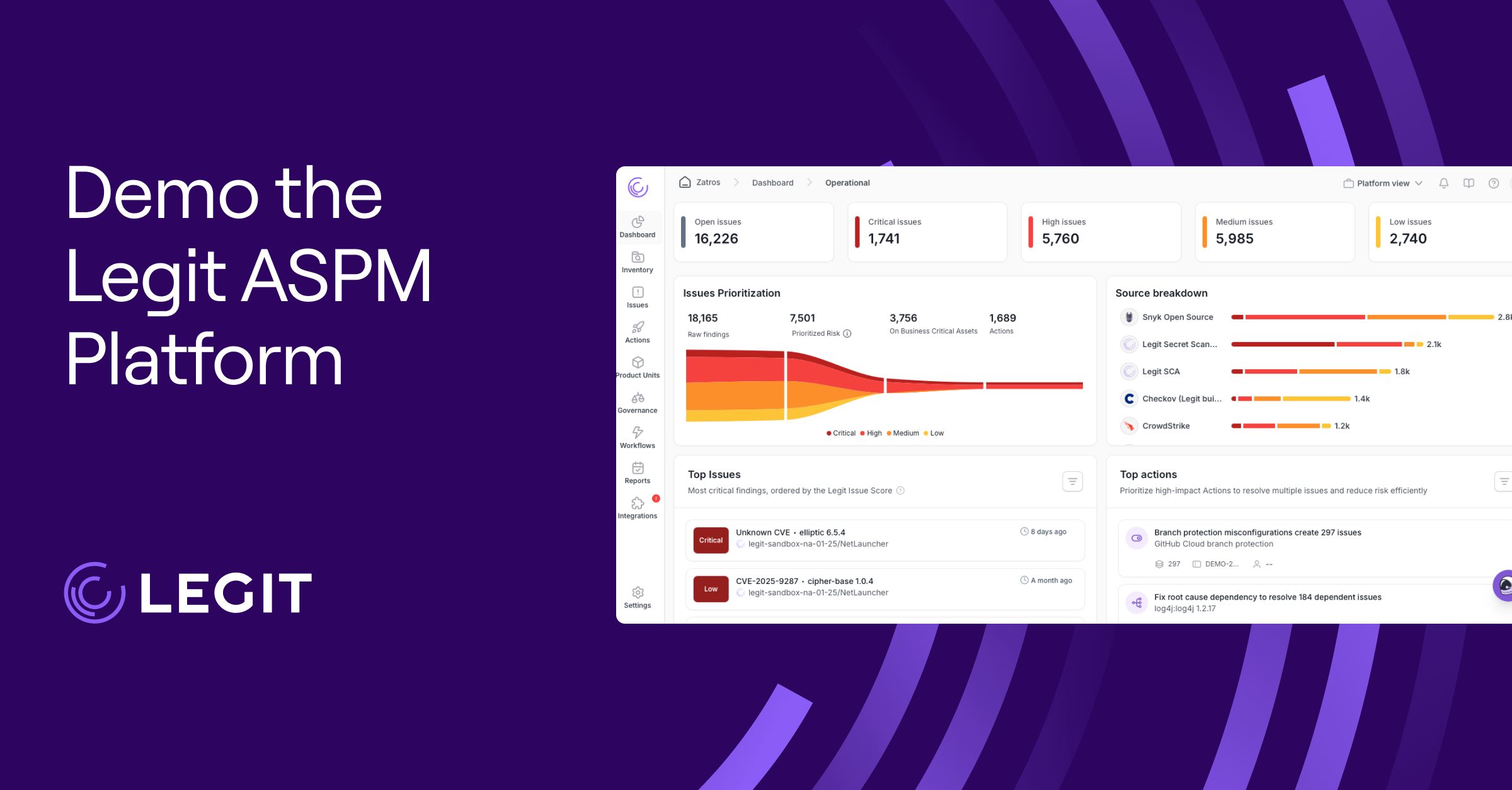Rapid innovation is the lifeblood of many companies in the digital age. If your organization employs a CI/CD workflow, you need an effective application risk management strategy to secure your SLDC pipeline and DevOps processes. And one of the most critical aspects of that strategy is a well-defined risk assessment strategy. But what does that actually mean?
In this blog, we’ll discuss how to perform effective application security risk assessments that allow you to maintain an innovative and rapid application development strategy without sacrificing risk management best practices or introducing unnecessary technical risk.
What is an application risk assessment?
An application risk assessment evaluates the security risks associated with a specific application or set of applications in order to identify potential vulnerabilities and threats and to better understand their potential impact, answering a series of questions like these. These are threats that could be used to compromise the security of your applications and the data they handle. The output of the assessment is usually a report that can be used to inform the development of a risk management plan or used to provide insights to the IT or security teams for specific recommendations. ISACA provides a comprehensive writeup of how to get started in this resource guide: Application Security Risk: Assessment and Modeling.
A thorough application risk assessment should also consider different types of attacks and threat actors, such as sophisticated attackers, internal threats, and social engineering. Additionally, it should take into consideration the regulatory and compliance requirements that apply to the organization and the specific application.
5 Application Risk Assessment Best Practices Every Business Needs
When it comes to securing your organization's applications, there are many best practices you should follow, and a risk assessment is an essential step in identifying potential vulnerabilities and threats. But performing one-off risk assessments doesn’t cut it in enterprise application risk management. Using IT risk management best practices allows you to continuously and effectively identify and evaluate threats to your applications and SLDC assets, allowing you to take the necessary steps to mitigate or eliminate them and ensure the security and integrity of your applications and data. Let's explore the 5 best practices for successful application risk assessments for practical business needs.
1. Establish & Stick to an Assessment Frequency
The first step in building a strong risk analysis framework is to decide how often you should perform application risk assessments and then establish a consistent and manageable assessment frequency. Taking this first step allows you to set organization expectations for key stakeholders in the process, allowing all parties to set a clear, security-minded standard for application risk assessments.
Obviously, risk assessment frequency is going to vary between organizations, but as a general best practice should be performed at least twice per year. Each organization will have to determine its own cadence based on a variety of inputs, first and foremost being an attainable frequency based on the budget and time that they can allocate to the process, both of which will be heavily influenced by staffing capacity and other priorities. And a combination of internal and customer-driven requirements may drive mandated assessment frequency in response to an internal audit, compliance, and 3rd party security standards requirements. Finally, best practices will also dictate frequency based on the cadence and quantity of major application changes per organization that have the potential to impact application security.
It is important to note that with a risk assessment, organizations can baseline or benchmark their current level of risk and are able to create a plan of action as a result. With a play to start and having key metrics, it gives all stakeholders a method to measure where they are at and plan where they would like to be as an organization from a security perspective. It's difficult to plan without background data, and many leverage KPIs (key performance indicators) to measure long-term change.
2. Create a Comprehensive Culture of Accountability
One of the key blockers to effective cyber risk assessment programs is their time-consuming and manual nature. The work is repetitive and boring, and responsible teams frequently ignore technical risks to focus on more interesting or immediately critical threats. And team members are frequently slow to act on important information risk mitigation measures due to a lack of visibility and, at times, a resulting fear of failure.
But effective information risk mitigation is impossible without following the fundamentals, and that means empowering your team members to quickly identify and remediate potential security threats. Building a comprehensive, internal culture of accountability is critical to program success, and you can find several valuable recommendations for how to do so here.
These can provide a guideline for building your own operating framework that will make accountability a positive team goal, providing the resources necessary to execute without the fear of failure. Greater accountability leads to greater transparency and ultimately delivers better incident prevention and response.
3. Simplify the Remediation Process with Standardization
With constant time and resource constraints and a chronic shortage of trained AppSec professionals, feasibility is always a struggle when implementing a cybersecurity risk management plan. The success of your application risk assessment and remediation program is dependent on giving your team a simplified and repeatable process that minimizes confusion and overhead.
Standardization is a key component of making that happen, but to do so effectively requires really digging deep and embracing the development of a comprehensive and thorough cybersecurity risk management plan. You have to know your applications inside and out to take actions like applying a relevant application risk rating to keep your risk remediation activities focused on the threats with the greatest potential impact. Not only will this optimize your cybersecurity risk management plan it will also deliver greater insight into previously unseen or unanticipated vulnerabilities in your software supply chain.
Standardization in vulnerability and risk management is more than just a logical strategy, it’s also now a recommended process in the Executive Order on Improving the Nation's Cybersecurity (see Sec. 6. Standardizing the Federal Government’s Playbook for Responding to Cybersecurity Vulnerabilities and Incidents.)
4. Think Like an Attacker
Anticipation of likely attacks is a critical component of IT risk management best practices, and that includes understanding where attackers are most likely to exploit your applications. That’s why it’s so important to think like potential attackers and employ a range of proactive project risk management best practices like threat modeling, defined by OWASP as “A structured representation of all the information that affects the security of an application.”
Threat modeling offers valuable insight into where attacks are likely to take place, which in turn allows your application security teams to understand where they need to focus first. With a clear-cut understanding of which components of the SLDC are most at risk with the context behind that assessment, application security teams can quickly and clearly communicate a mitigation plan with the teams responsible for mitigation. This shift to anticipatory mitigation strategies can have a transformational effect on the overall efficacy and success of application risk management programs.
Keep in mind that if done correctly, threat modeling can provide a “clear line of sight” that helps justify security operations and improvements. With all the information on the table, the threat model allows security decisions to be made with a higher degree of confidence.
5. Lead with a Security-First Approach
Changing an organization’s culture and approach to application risk management to keep up with the continuous evolution of the software development lifecycle (SDLC), accounting for advancements like DevOps processes and the cloud, means rethinking application security for DevOps and scale. A security-first culture is necessary but needs to be driven by leadership with a top-down approach for it to be successful. Company leadership needs to establish priorities for teams up front to ensure that the right security protocols and measures, like application security risk assessments, are adequately prioritized.
With a leadership-driven, security-first approach to application risk management, activities like application security risk assessments become a part of the regular operating landscape. This helps remove the ambiguity that keeps many cybersecurity teams from effectively prioritizing risk management and mitigation activities. A clear-cut set of directives, guided by regular risk assessments and understood organization-wide, drives a stronger culture of accountability and more effective application security.
Many organizations have found success with security evangelists or security champions. These individuals, especially on the software development team, helps spark security first mentality by being early adopters of good security methods and best practices. Leading by example, these leaders emerge from development as key players in changing the company approach towards DevSecOps, where security is integrated with operations rather than at odds with operations.
Get the Most from Your Application Risk Assessments
With today’s CI/CD approach to the SDLC, organizations are increasingly driven to rethink their approaches to application security. By following these best practices, you can ensure that your application risk assessments are thorough, accurate, and effective. Keep in mind that the risk assessment process is an essential part of any organization's overall security and compliance strategy and should be integrated into your overall risk management program.
Additionally, it's important to be aware of the specific regulations that might apply to your industry, as they can be a good point of reference for risk assessment and management. And as you map out your organization’s strategy towards transforming how you approach application security, it’s a great time to identify, evaluate, and implement solutions that can help you perform these activities more efficiently and cost-effectively.
Legit secures your applications from code-to-cloud with automated SDLC discovery and analysis capabilities and a unified application security control plane that provides visibility, security, and governance over rapidly changing application development environments.
If you’d like to learn more about the Legit Security Platform or take the free Rapid Risk Assessment to see how we can help modernize your application security program, meet with one of our subject matter experts and schedule a demo today.
Download our new whitepaper.


